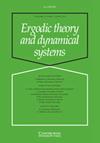On a self-embedding problem for self-similar sets
IF 0.8
3区 数学
Q2 MATHEMATICS
引用次数: 0
Abstract
Let关于自相似集合的自嵌入问题
让 $Ksubset {\mathbb {R}}^d$ 是由满足强分离条件的迭代函数系统 $\{\varphi _i}_{i=1}^m$ 生成的自相似集合,并让 f 是具有 $f(K)\subseteq K$ 的收缩相似。我们证明,如果所有 $\varphi _i$ 都有一个共同的收缩比和正交部分,那么 $f(K)$ 在 K 中是相对开放的。当允许正交部分变化时,我们还提供了一个反例。这部分回答了埃莱克斯、凯莱蒂和马特的一个问题[Ergod.作为我们论证的副产品,当 $d=1$ 且 K 包含两个满足强分离条件但收缩比符号相反的同质生成迭代函数系统时,我们证明 K 是对称的。这部分回答了冯和王的一个问题[Adv. Math.222 (2009), 1964-1981]。
本文章由计算机程序翻译,如有差异,请以英文原文为准。
求助全文
约1分钟内获得全文
求助全文
来源期刊
CiteScore
1.70
自引率
11.10%
发文量
113
审稿时长
6-12 weeks
期刊介绍:
Ergodic Theory and Dynamical Systems focuses on a rich variety of research areas which, although diverse, employ as common themes global dynamical methods. The journal provides a focus for this important and flourishing area of mathematics and brings together many major contributions in the field. The journal acts as a forum for central problems of dynamical systems and of interactions of dynamical systems with areas such as differential geometry, number theory, operator algebras, celestial and statistical mechanics, and biology.

 求助内容:
求助内容: 应助结果提醒方式:
应助结果提醒方式:


